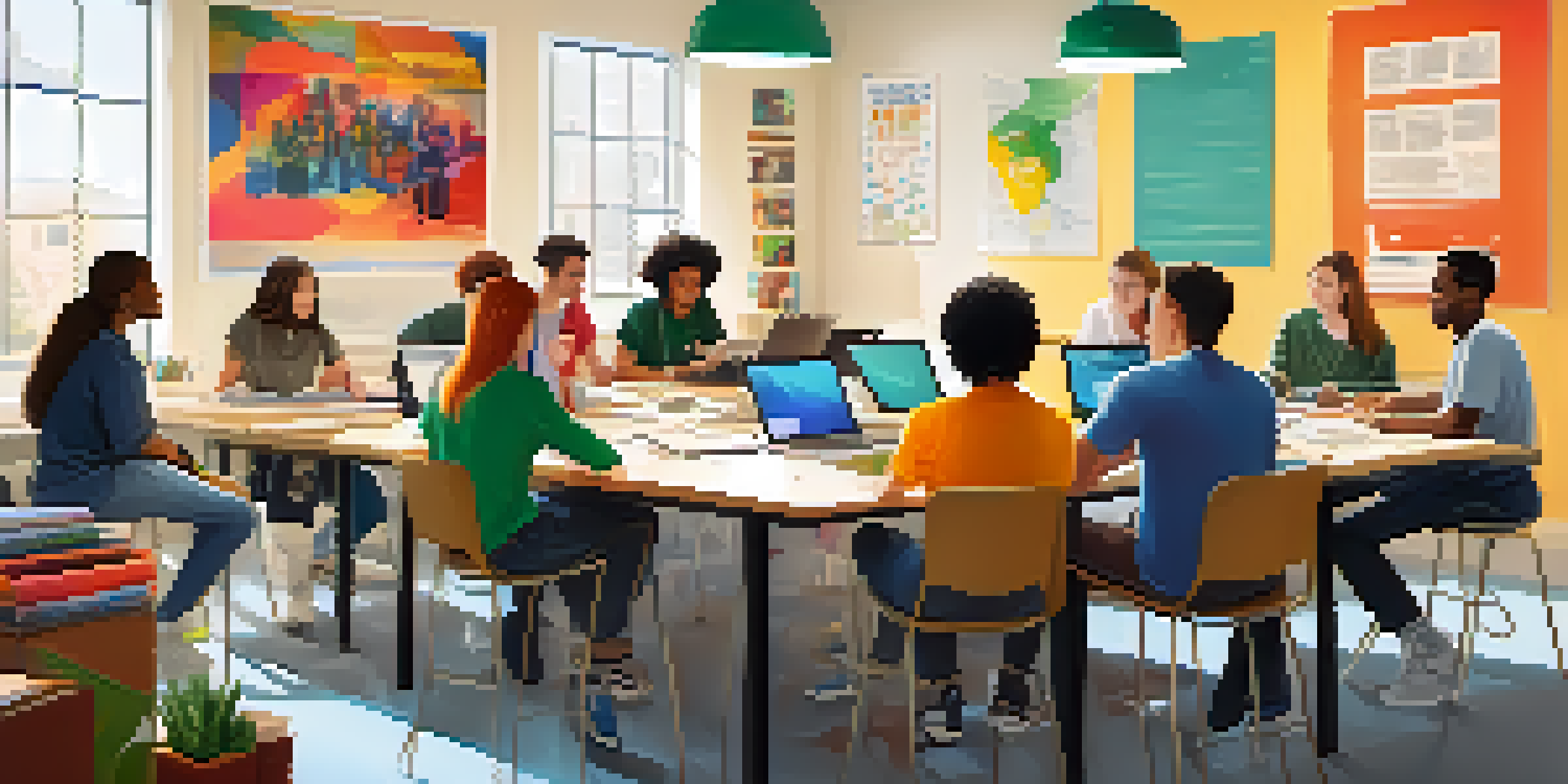Assessing Student Learning Through Collaborative Tools

Understanding Collaborative Tools in Education
Collaborative tools are digital platforms that allow students to work together, share ideas, and complete projects in real-time. Examples include Google Docs, Padlet, and Microsoft Teams, which facilitate communication and teamwork. These tools not only enhance learning but also help assess students' understanding and engagement.
Alone we can do so little; together we can do so much.
By providing an environment where students can collaborate, teachers gain insight into individual contributions and group dynamics. This helps in evaluating not just what students know, but how they interact and apply their knowledge. Understanding these dynamics is crucial for fostering a supportive learning atmosphere.
Moreover, collaborative tools can bridge the gap between remote and in-person learning. As education evolves, leveraging technology ensures that all students have the opportunity to participate and demonstrate their learning effectively, regardless of their physical location.
The Role of Assessment in Collaborative Learning
Assessment is a vital part of the learning process, providing feedback on student understanding and performance. In collaborative settings, assessment shifts from a sole focus on individual achievement to a more holistic view of group dynamics and collective outcomes. This approach encourages students to support each other and work towards shared goals.

Using collaborative tools allows educators to create diverse assessment formats, such as peer reviews or group presentations, which reflect real-world scenarios. These methods promote accountability among students, as they realize their contributions impact the entire group's performance. Engaging in this way not only enriches their learning experience but also prepares them for future teamwork.
Collaborative Tools Enhance Learning
Digital platforms like Google Docs and Microsoft Teams facilitate real-time collaboration, boosting student engagement and understanding.
Additionally, formative assessments can be seamlessly integrated into collaborative projects, allowing for ongoing feedback. This iterative approach empowers students to reflect on their learning continuously and make necessary adjustments, fostering a growth mindset that benefits their academic journey.
Creating Collaborative Assessment Strategies
To effectively assess student learning through collaboration, teachers must design clear and structured assessment strategies. This includes defining specific learning objectives and outlining expectations for both individual and group contributions. A well-structured rubric can serve as a guide to ensure that all students understand how they will be evaluated.
Collaboration allows us to know more than we are capable of knowing by ourselves.
Incorporating self-assessment and peer evaluation into the strategy encourages accountability and reflection among students. By asking students to assess their own contributions and those of their peers, they develop critical thinking skills and a deeper understanding of the collaborative process. These reflections can be valuable for both learning and assessment.
Lastly, it's essential to provide opportunities for students to discuss their experiences and challenges in collaborative projects. Open discussions can lead to insights about what worked well and what didn’t, allowing educators to refine their assessment strategies and enhance future collaborative learning experiences.
Utilizing Technology for Effective Assessment
Technology plays a crucial role in facilitating collaborative learning and assessment. Digital tools enable teachers to track student progress in real-time, allowing for immediate feedback and intervention when necessary. For instance, platforms like Edmodo or Google Classroom can simplify the process of collecting and analyzing student work.
Moreover, the use of analytics in these platforms can provide educators with valuable insights into group performance and individual engagement levels. This data can inform instructional decisions, helping teachers identify students who may need additional support or those who excel in collaborative environments. By leveraging technology, assessments can become more personalized and responsive to student needs.
Assessment Shifts to Group Dynamics
In collaborative settings, assessment focuses on collective outcomes and peer contributions, promoting accountability among students.
Additionally, technology can enhance the creativity of collaborative projects by allowing students to integrate multimedia elements into their presentations. This not only makes learning more engaging but also helps assess a wider range of skills, from technical proficiency to critical thinking and creativity.
Fostering a Growth Mindset Through Collaboration
Promoting a growth mindset is essential in a collaborative learning environment. When students see challenges as opportunities to learn, they are more likely to engage positively with their peers and contribute to group tasks. Collaborative tools can support this mindset by providing a platform for sharing successes and discussing areas for improvement.
Encouraging students to celebrate collective achievements can strengthen group cohesion and foster a supportive atmosphere. When students recognize their contributions to a team effort, they develop a sense of ownership and responsibility for their learning. This shift in perspective can lead to enhanced motivation and a deeper commitment to the collaborative process.
Moreover, allowing students to learn from their mistakes in a safe space promotes resilience. When assessments focus on the learning journey rather than just the final product, students are more likely to embrace challenges and persist through difficulties, ultimately leading to improved learning outcomes.
Challenges in Assessing Collaborative Learning
While assessing student learning through collaborative tools has many benefits, it also presents unique challenges. One common issue is ensuring that all students contribute equally to the group work, which can lead to discrepancies in assessment. Teachers may need to implement strategies to monitor participation and ensure that no student is left behind.
Another challenge lies in evaluating both individual and group performance. Striking the right balance between assessing the group as a whole and recognizing individual contributions can be tricky. Educators must be clear about their expectations and consider using multiple assessment methods to achieve a comprehensive understanding of student learning.
Tech Innovations Shape Assessments
Emerging technologies like AI are paving the way for personalized assessments that cater to individual needs while encouraging teamwork.
Lastly, the reliance on technology can also pose challenges, such as technical difficulties or unequal access among students. Educators must be aware of these disparities and work to create an inclusive environment where all students can participate fully in collaborative assessments.
Future Trends in Collaborative Learning Assessment
As education continues to evolve, so do the methods for assessing student learning in collaborative environments. The rise of artificial intelligence and adaptive learning technologies offers new possibilities for personalized assessments that cater to individual student needs while still promoting teamwork. These innovations can enhance the effectiveness of collaborative assessments significantly.
Moreover, the shift towards blended learning environments is likely to influence how assessments are conducted. Educators may increasingly use a combination of online and face-to-face collaboration, allowing for diverse assessment opportunities that reflect different learning styles and preferences. This flexibility can lead to more meaningful evaluations of student learning.

Finally, there is a growing emphasis on social-emotional learning (SEL) and its role in collaborative assessments. Understanding how students interact, communicate, and support each other in group settings will become increasingly important. Educators will likely incorporate SEL metrics into their assessment strategies to foster a more holistic approach to student development.